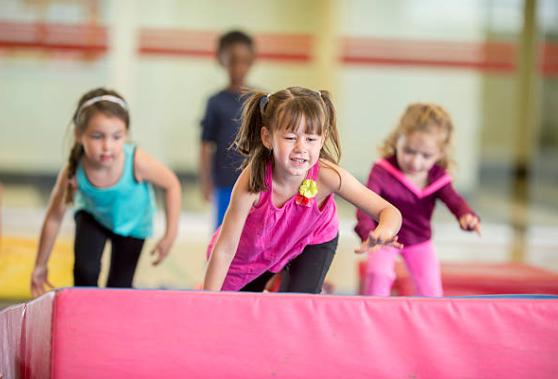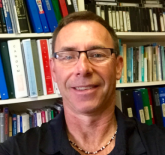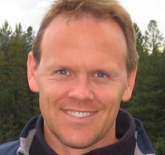Gymnastics for Every Student

Previously published in Volume 82, Issue 2
Physically active and inclusive gymnastics for all students is possible. Even without adult supervision or direction, many children independently and naturally engage in gymnastics-related movements. You can witness this while walking down the street on a summer day: children are likely to be kicking to handstands, performing cartwheels, or tossing a ball and then spinning before catching it again.
Something said to us many years ago, continues to resonate: “Physical educators are like carpenters who construct and build both life and sporting foundations for today’s youth.” Just as a carpenter needs a strong base or foundation upon which to build a durable house, the human body needs a foundation upon which to develop, grow, learn and move.
As physical educators, we need to prepare students for the many movement-related challenges they will encounter throughout their lifespans. We can do this by improving students’ physical competency in skills related to manipulation, locomotion and non-locomotion, while also attending closely to movement concepts—related, for example, to body, effort, space and relationships. It is our job, as physical educators, to improve students’ physical literacy with the best methods available. To us, gymnastics is among those best methods.
Gymnastics as a safe and practical activity
Still, despite the clear evidence suggesting gymnastics in schools is a great activity for developing physical literacy, many physical educators (particularly generalist teachers charged with teaching physical education) view gymnastics as an activity to be avoided or feared. Such physical educators are often apprehensive about perusing it with their students. Concerns about legal liability, a lack of proper or suitable equipment, and a lack of comfort with teaching gymnastics skills and progressions have made gymnastics all but disappear in many physical education programs.
We believe it is time to change this way of thinking about gymnastics (or more specifically, it’s time for us to contribute to the call that’s already underway). Physical educators need to attend to a framework and a simpler design to help them deliver a safe and practical gymnastics experience within their physical education programs. We suggest this can be done by attending the National Coaching Certification Program’s (NCCP) and Gymnastics Canada’s foundational movement patterns approach.
An educational framework for gymnastics in schools
The NCCP level one coaching certification for gymnastics was developed, revised and improved largely through the contributions of Dr. Keith Russell, a former professor at the University of Saskatchewan. His guiding educational philosophy focused on providing gymnastics activities for children with three specific goals in mind:
-
Children must have fun.
-
Children must gain some fitness benefits.
-
Children must acquire some solid fundamentals of gymnastics.
All three of these principles can be accomplished by using the educational gymnastics foundational movement patterns approach. While attending to provincial safety guidelines (that regulate equipment, clothing, facility and special rules and regulations for elementary and secondary school gymnastic classes), physical educators ought to strive to accomplish these philosophical goals set out by NCCP and Gymnastics Canada. If physical educators can distance themselves from the traditional limiting gymnastics influences (e.g., traditional artistic gymnastics equipment with difficult skills and stunt aspects), they can develop a safe and responsible gymnastics program.
Sound teaching strategies for fun
The first goal is to teach gymnastics while also ensuring students are having fun. Physical educators must incorporate sound teaching strategies within their classrooms and gymnasiums to do this. This means every physical educator needs to be creative and needs to provide opportunities for constant movement and participation. Idleness and standing in line are not suitable options for nurturing fun within lessons. Being active and participating fully are key prerequisites for keeping children engaged and having fun while learning movement concepts.
Physical educators also need to consider age-appropriate material for children when they are teaching gymnastics. Students need to be successful and they need to achieve something specific within their own levels of cognitive and physical development. They need to be physically challenged, but not subjected to dangerous or unattainable skills. Not all students can, or should, be expected to perform the same gymnastics-type skills. They must, individually, be able to succeed and feel accomplished in their efforts. This also requires physical educators to adapt and allow for students’ many differences in physical ability, intellectual ability and body type. By providing several ways to challenge children, all of them may individually respond in a positive way.
One of the best strategies to achieve this, once basic safety and instructional strategies have been put into place, is to develop a circuit pattern. A physical educator can schematically design a simple equipment pattern using picture task cards; students can then move through the circuit with the instruction that all individuals may change, modify or vary the tasks to respect and recognize their own ability, creativity and individualism with each skill.
Gymnastics for fitness
The second goal is to ensure students’ fitness is a purposeful part of gymnastics instruction. Physical educators need to recognize that performing the many gymnastics skills and movements is an ideal way to maintain or improve upon students’ health- and sport-related physical fitness. This should be a welcome suggestion for physical educators; they have worked diligently to help their students improve strength, flexibility, power and endurance. Gymnastics-related activities provide an ideal means to accomplish this.
By including repetition, chaining or sequencing of skills, students’ adaptations to stamina, strength, speed and suppleness can be drastically improved over time. Improving the proficiency that students have with gymnastics skills and movements will also challenge and improve their balance, spatial orientation, agility and coordination at the same time.
If we truly want to address the many facets of physical fitness and literacy, we need to place children into situations where they can use their own body weight while stabilizing and supporting themselves while their bodies are inverted, in flight and rotating. It is our goal to make students “indestructible”—or physically self-sufficient in daily life.
Six foundational movement patterns
The third goal of an educational gymnastics program is to focus on the development of fundamental movement skills that play a significant role in children’s lives and individual sporting skills. We suggest the foundational movement patterns approach is the best way to consider gymnastics’ fundamental and sport-specific skills. This approach looks at many skills and categorizes them into six themes.
Landing
There are four sub-themes of landings: landing on the feet, landing on the hands, landing on the back, and landing with rotation. This movement pattern is one of the most important ones. Landings enable an individual to bring control to a position or to land in a stable and safe position from either linear or rotational motion or from height. Landings, for the most part, are a controlled element or a termination element to stop a movement or to safely get off of an object. Additionally, landings are responses to mistakes. They are the body’s automatic response when making corrections or protecting oneself from injury caused by an unexpected fall.
Statics
There are three sub-themes of statics: supports, balances and hangs. All static skills in gymnastics have one thing in common: the body’s centre of mass remains within the body’s base of support. All three sub-themes of statically held positions are building points and references for all the other foundational movements. Static positions are a great way to challenge students and to get them to work together, both cooperatively and competitively.
Rotations
There are three sub-themes of rotations: transverse axis, longitudinal axis and anterior-posterior axis. Rotations can be done around these three internal axes in a forward, backward, or sideward direction. Transverse axis includes skills such as forward and backward rolls. Longitudinal axis is turning or twisting vertically or horizontally. The anterior-posterior axis is the cartwheeling axis.
Locomotions
There are three sub-themes of locomotions: locomotion on feet, locomotion in support and locomotion in hang. A locomotion is a movement pattern in which the body repetitively moves outside its base of support. The movement can be forward, backward, sideways or in any pattern. Locomotor activities can be performed individually or with a partner or a group.
Springs
There are three sub-themes of springs: springing on the feet, springing on the hands, and springing on the feet and hands (combined). Many gymnastics activities are the result of a single dynamic takeoff or spring. Springs can occur from two feet, one foot, two hands or a combination of both.
Swings
There are two sub-themes of swings: swing in hang and swing in support. A swing can be described as a rotation about an external axis such as a bar, rings, or side horse. All swings begin from a stationary support or a hanging position.
Physical educators need to understand the instructional framework of these basic foundational movement patterns. They need to promote and challenge students with gymnastic elements that suit their students’ needs and abilities. Through practice and exposure to gymnastics-related movement skills, all children may become better in many of the physical, psychomotor and cognitive values derived along our life-path towards physical literacy.
Promoting gymnastics in our schools
We believe that all physical educators are all working towards common goals. They all want to improve their students’ physical literacy. In all the workshops and teaching retreats that we have led, the majority of teachers who attended shared this opinion. Many physical educators do support gymnastics and see the tangible benefits of exposing children to gymnastics-related activity. So what is the next step to encourage and promote more gymnastics in our schools?
Many physical educators want to be more creative and are willing to adapt and modify gymnastics activities. Gymnastics movements need to be performed more frequently within many schools’ physical education programs. If physical educators are still hesitant to teach gymnastics, they might disguise it and give it any other name. Either way, physical educators need to appreciate how to challenge a wide diversity of students with key gymnastics skills. They need to make instruction more physically demanding than skill demanding. With all this in mind, physical education teachers need to maintain a strong educational focus while remembering that children want to “play” gymnastics, just as they similarly want to play basketball, soccer or badminton.
We want physical educators to teach gymnastics and to teach it often. We also want to enable access to high-quality, easy-to-use teaching resources so they can attend to NCCP’s and Gymnastics Canada’s foundational movement patterns approach.
Gymnastics resources for physical educators
To encourage physical educators to continue to improve their development with gymnastics, we have created a website that provides physical educators with more than 150 games and activities to complement the six foundational movement patterns. Also included in this resource are two or three selected instructional videos for skills for each foundational movement that all physical educators should feel comfortable instructing. All the games and skill progressions can be viewed on hyperlinked YouTube videos. To access this resource, visit http://people.stfx.ca/kthompso and get excited about challenging your students and letting them find out the joys and challenges with gymnastic movements.









